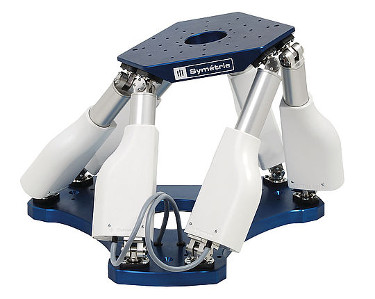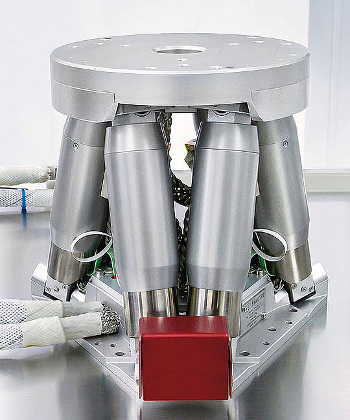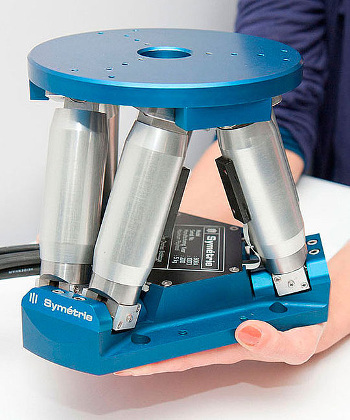 |
| June 16, 2015 | Volume 11 Issue 23 |
Designfax weekly eMagazine
Archives
Partners
Manufacturing Center
Product Spotlight
Modern Applications News
Metalworking Ideas For
Today's Job Shops
Tooling and Production
Strategies for large
metalworking plants
How exact-positioning hexapods enable research in space
Fitted with six powerful DC motors, they can achieve an incredible degree of accuracy.
Why is it much warmer 1 million km away from the sun than on its surface? Even today, we still do not have a definitive answer to this seemingly simple astronomy question. However, two satellites set to go into orbit in 2017 in a formation accurate down to the last millimeter may be able to help solve the mystery.

One satellite will cover the sun, and the other will be able to observe the hot solar corona undisturbed. In order to install the measuring instruments for this incredible feat of precision, the technicians at the European Space Agency (ESA) used a hexapod. Manufactured by SYMETRIE, a high-tech company based in the South of France, the hexapod was powered by motors produced by FAULHABER.
During a solar eclipse, it is possible to see the solar corona or aureole surrounding the darkened surface of the sun with the naked eye. Comprised almost entirely of ionized plasma, it extends into space to a distance up to three solar radii. With a temperature of several million Kelvin, it is so hot that the 5,778 Kelvin on the sun's surface almost seems cool in comparison.
Up until now, the reason for this enormous difference could not be investigated in detail. On Earth, large parts of its radiation are swallowed up by the atmosphere, while in space, observation is subject to technological limitations -- the surface of the sun must be covered so that it does not outshine the corona; however, with the equipment currently available, this means that the part of the solar corona that is close to the sun is also hidden.
A hair's breadth
For this reason, as part of its StarTiger program, the ESA plans to launch two satellites in 2017 that are set to travel in a unique formation. They will orbit the Earth at a distance of just 150 m to each other -- and at a speed of several kilometers per second, that is truly the proverbial hair's breadth. The shield of one of the satellites is set to cover the sun in such a way that the instruments on the other will be able to capture the radiation of the corona to a degree not previously possible.
To facilitate optimum alignment of both satellites as well as the instrumentation on board, the ESA technicians have simulated the conditions of space travel at the Laboratory of Astrophysics in Marseilles, France. A coronagraph, which is set to capture the radiation of the solar corona on the satellite that is in the shade, has been mounted on a BREVA hexapod (a "six-legged" robot) manufactured by SYMETRIE. In each leg, a brushless DC motor is installed with an integrated encoder. By extending and retracting the legs, the platform mounted on top can be adjusted freely in any direction. Thanks to the outstanding dynamics and power density of FAULHABER drives (even in the smallest spaces) as well as the high encoder resolution, large masses can be positioned quickly, reliably, and precisely.
A mirror for the next Hubble
Thanks to this freedom of movement, the ESA technicians have been able to simulate a variety of positions for the "flying machines" in relation to one another. The hexapod is distinguished by a number of features that make it ideal for the task at hand, as SYMETRIE managing director Olivier Lapierre explains, "It performs under the most limited tolerances -- the minimum movements required with exact precision, yet is also extremely rigid and can thus accurately maintain the specified position." A further strength of the product is its sophisticated software that ensures smooth component interaction and allows, for example, any virtual center of rotation to be specified for the platform and particularly gentle sequences of movement to be achieved.

These features of the SYMETRIE precision hexapods are also in use in other space programs such as the James Webb Space Telescope, which is set to replace the famous Hubble telescope in 2018, as well as in the GAIA project aimed at mapping the Milky Way. In each of these projects, hexapods are being used to mount optical units. Lapierre describes a typical task as follows, "The hexapod helps to adjust a mirror in the specified position with sub-micrometer precision." As is the case with StarTiger, an almost incredible degree of accuracy is required, and the Webb telescope should theoretically be able to detect a single candle on one of the moons of Jupiter.
The most powerful X-ray beam
The BORA hexapod used for the GAIA project was not originally developed for astronomy, but for the observation of extremely small objects. It originated as part of a collaboration with the European Synchrotron Radiation Facility (ESRF) in Grenoble, France. The synchrotron in the French Alps accelerates electrons almost up to the speed of light, causes them to collide, and generates the world's most powerful X-ray beam. It is around 10,000 times more powerful than the output of a medical X-ray device, yet as fine as a human hair.
This beam is used to analyze a whole range of samples and materials, from semi-conductor crystal structures through to molecular movements in living cells. "Our hexapods are used at the ESRF to move calibration mirrors and samples into specific positions and to accurately maintain those positions thanks to their excellent stability," says Lapierre.

Regardless of whether we are looking into the infinity of space or at detailed structures at the molecular level, the essential requirements that a positioning hexapod must meet remain the same: maximum maneuverability and precision together with absolute stability. Additional specifications may be added depending on the application. Both for ESA and at the ESRF, a considerable amount of work is performed in a vacuum or cleanroom environment where the equipment must, obviously, also meet corresponding requirements. Space is also often at a premium, which means that mini-hexapods are required.
The ideal solution for positioning in the smallest of spaces is the BREVA model's little brother, BORA. With a footprint diameter of 212 mm (8.3 in.), it is only 145 mm tall (5.7 in.). Despite these diminutive dimensions, it can move a load up to 10 kg (22 lb) at a resolution of 0.1 micrometers on its directional axes and of 2 microrads on the rotational axes.
"The FAULHABER motors play an essential role in our hexapods, offering the best combination of compact sizing and product quality on the market," says Lapierre.
Source: MICROMO, the U.S. provider of FAULHABER motor technologies
Published June 2015
Rate this article
View our terms of use and privacy policy
